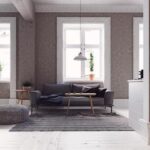Are you wondering how to decorate your colonial home? Whether you’re the proud owner of a historic property or simply drawn to the timeless elegance of colonial architecture, understanding the key features and design elements that define this style is essential for creating an authentic and inviting space.
From embracing traditional colonial colors to selecting furniture and decorative elements that complement the architectural style of your home, there are numerous ways to bring the charm of colonial design into your living space.
Colonial architecture is characterized by its symmetry, columned facades, and multi-pane windows, all of which contribute to its classic and stately appearance. By exploring the classic color palettes commonly used in colonial homes, such as earthy tones, deep reds, and navy blues, you can incorporate these colors into your home decor to evoke a sense of timeless elegance. Additionally, selecting furniture with characteristics true to colonial design will enhance the authenticity of your space.
In addition to selecting furniture pieces that match the architectural style of your home, incorporating decorative elements such as crown molding, wainscoting, and brass hardware is crucial for enhancing the colonial charm of your interior spaces.
From designing a grand entryway that sets the tone for the rest of your colonial home to using traditional fabrics like chintz, paisley, and damask in upholstery and drapery – there are endless possibilities for capturing the essence of colonial design in every aspect of your decor.
Embracing Traditional Colonial Colors
When it comes to decorating a colonial home, embracing traditional colonial colors is essential in capturing the timeless and classic aesthetic of this architectural style. The color palettes commonly used in colonial homes are steeped in history and reflect the natural surroundings of the original colonies.
Earthy tones such as warm browns, deep reds reminiscent of brick, and navy blues inspired by the sea are signature colors that can be incorporated into your home decor to achieve an authentic colonial look.
Here are some ways you can incorporate traditional colonial colors into your home decor:
1. Walls: Paint your walls in earthy tones like terracotta, ochre, or olive green to create a warm and inviting atmosphere. Consider using a deep red hue for an accent wall to add depth and richness to your space.
2. Furnishings: Introduce navy blue accents through upholstered furniture pieces such as sofas, armchairs, or ottomans. Look for textiles with traditional patterns like paisley or damask in deep reds and earthy tones for throw pillows or curtains.
3. Accessories: Add pops of color with decorative accessories such as vases, candles, or artwork featuring classic colonial hues. Consider incorporating brass or copper accents to complement the warm undertones of the earthy color palette.
Incorporating these traditional colonial colors into your home decor will help capture the essence of colonial style and create a cohesive look throughout your living spaces.
By paying attention to these classic color palettes and incorporating them into every aspect of your interior design, you can achieve an authentic Colonial look that takes you back to a different era while still feeling modern and comfortable today.
Selecting Colonial-Inspired Furniture
When decorating a colonial home, it’s important to select furniture that complements the architectural style of the house. Colonial furniture is known for its sturdy construction, simple lines, and classic elegance. Pieces are often made from solid wood and feature traditional design elements such as turned legs, intricate carvings, and brass hardware. When choosing colonial-inspired furniture for your home, consider pieces with a timeless appeal that will complement the overall aesthetic of your space.
One of the key characteristics of colonial furniture is its craftsmanship. Look for well-made pieces constructed from high-quality materials that are built to last. Traditional colonial styles include Chippendale, Queen Anne, and Pennsylvania Dutch, each with its own unique features and influences. To achieve an authentic colonial look in your home, opt for furniture that reflects these historical styles while also incorporating modern comfort and functionality.
When selecting colonial-inspired furniture for your home, focus on pieces that will enhance the charm and character of your space. Consider items such as Windsor chairs, mahogany dining tables, four-poster beds, and wooden chests to bring a sense of history and tradition into your decor. Mix and match different pieces to create a curated look that feels both cohesive and inviting.
In addition to the style and construction of colonial furniture, consider how each piece will fit within the layout of your home. Take into account the scale of the furniture in relation to the size of your rooms, ensuring that each piece complements the space without overwhelming it. By carefully selecting colonial-inspired furniture that aligns with the architectural style of your home, you can create a timeless and elegant living environment that pays homage to America’s rich history.
| Colonial Furniture Characteristics | Tips for Choosing Furniture |
|---|---|
| Sturdy construction | Consider well-made pieces made from solid wood |
| Traditional design elements | Look for timeless appeal combined with modern comfort |
| Incorporates historical styles | Focus on enhancing charm and character of space |
Incorporating Colonial Decorative Elements
Enhancing Your Home With Crown Molding
Crown molding is a classic decorative element that adds elegance and sophistication to any colonial home. Typically made from wood, crown molding can be used to define the transition between walls and ceilings, creating a visually appealing architectural detail. When selecting crown molding for your home, consider traditional designs with intricate patterns or simple, streamlined profiles that complement the overall style of your home.
Adding Wainscoting for Timeless Appeal
Wainscoting is another key decorative element in colonial homes, serving both a functional and aesthetic purpose. This paneling is often used on the lower half of walls to protect them from wear and tear, while also adding visual interest and texture to interior spaces. Traditional wainscoting designs may include raised or recessed panels with decorative trim, and can be painted in classic colonial colors to maintain an authentic look.
Accessorizing With Brass Hardware
Brass hardware such as door handles, knobs, hinges, and cabinet pulls can make a significant impact on the overall charm of a colonial home. The warm, golden tones of brass complement traditional colonial color palettes and add a touch of luxury to interior spaces. When choosing brass hardware for your home, opt for timeless designs with intricate details that align with the architectural style of your home.
As you consider how to decorate your colonial home, paying attention to these important details will help you achieve an authentic and timeless look that honors the rich history and design heritage of colonial architecture. By incorporating decorative elements such as crown molding, wainscoting, and brass hardware into your home decor, you can enhance the colonial charm of your space while creating an inviting atmosphere that reflects the elegance of this iconic architectural style.
Creating a Welcoming Colonial Entryway
When it comes to decorating a colonial home, the entryway plays a crucial role in setting the tone for the rest of the house. Here are some ideas for designing a grand colonial entryway that will make a lasting impression:
- Traditional Door Styles: A classic colonial entryway often features a 6-panel or 8-panel door with decorative molding and brass hardware. Consider choosing a door with intricate details and a timeless design to enhance the colonial charm of your home.
- Architectural Details: To create an inviting entry, consider adding architectural elements such as pilasters, pediments, and transom windows above the door. These details can add visual interest and elegance to the façade of your colonial home.
- Colonial Lighting: Choose traditional lantern-style outdoor lighting fixtures to illuminate the entryway. Consider installing sconces on either side of the door or hanging a statement chandelier in the foyer to create a warm and welcoming ambiance.
In addition to these architectural elements, you can also incorporate traditional landscaping features such as symmetrical plantings, boxwood hedges, and classic urns or topiaries near the entryway. These outdoor elements will further enhance the colonial style of your home before guests even step inside.
By paying attention to these details when designing your colonial entryway, you can create a warm and welcoming first impression that sets the stage for the rest of your interior décor. This is just one important aspect in learning how to decorate my colonial home effectively.
Layering Colonial Textiles and Fabrics
When it comes to achieving a colonial-inspired look in your home, textiles and fabrics play a crucial role in capturing the essence of this traditional style. Colonial homes are known for their classic and timeless appeal, and incorporating traditional fabrics like chintz, paisley, and damask can help you achieve that charming colonial aesthetic throughout your living spaces.
Understanding Traditional Colonial Fabrics
Chintz, a glazed cotton fabric with colorful floral patterns, was commonly used in colonial homes for upholstery, drapery, and bedding. This durable and versatile fabric adds a touch of elegance to any room while infusing it with a sense of history.
Paisley, with its intricate teardrop-shaped motif, is another traditional colonial fabric that can be used to create a sophisticated and luxurious atmosphere. Additionally, damask, characterized by its elaborate woven patterns, is often seen in formal colonial interiors, adding richness and texture to upholstery and drapery.
Incorporating Traditional Fabrics Into Your Home Decor
To achieve a colonial-inspired look in your home decor, consider using these traditional fabrics in key areas such as upholstered furniture pieces like sofas or armchairs. You can also bring them into your living spaces through draperies or curtains to add a touch of classic elegance while embracing the timeless charm of colonial design. Additionally, incorporating these fabrics into bedding such as duvet covers or throw pillows can instantly elevate the overall aesthetic of your bedroom.
Tips for Selecting Colonial-Inspired Textiles
When choosing traditional fabrics like chintz, paisley, and damask for your colonial home decor, opt for rich earthy tones or deep jewel colors that were commonly favored during the colonial period. These colors will help maintain an authentic feel while evoking warmth and coziness in your living spaces. Furthermore, consider mixing these traditional fabrics with other elements such as antique furniture or decorative accessories to complete the cohesive look of your colonial-inspired interior design.
Displaying Colonial Art and Collectibles
Colonia homes are characterized by their historical charm, and one of the best ways to enhance this charm is by displaying colonial art and collectibles throughout your home. Whether you have inherited family heirlooms or have a passion for collecting antique items, showcasing these pieces can add character and personality to your living space.
To incorporate colonial art and historical collectibles into your home decor, consider incorporating items such as vintage maps, traditional oil paintings, handcrafted ceramics, or antique furniture pieces. These items not only bring a sense of history into your interior design but also serve as conversation starters for guests. Placing these items in prominent locations such as mantels, built-in shelves, or gallery walls can create a stunning focal point in any room.
When decorating with colonial art and collectibles, it’s important to ensure that these items are displayed in a cohesive and intentional manner. Group similar items together to create visually appealing vignettes that tell a story about the history of your home. Additionally, consider using appropriate lighting to highlight these pieces and create an inviting ambiance.
Ultimately, the key to successfully incorporating colonial art and collectibles into your home decor is to embrace the historical significance of these items while also allowing them to contribute to the overall aesthetic of your living space.
| Colonial Art & Collectibles | Home Decor Tips |
|---|---|
| Vintage Maps | Display on gallery walls or use as unique wallpaper prints |
| Antique Furniture Pieces | Showcase in prominent locations such as entryways or living rooms as focal points |
| Traditional Oil Paintings | Consider proper lighting placement to accentuate details and colors |
Landscaping and Outdoor Colonial Style
In conclusion, decorating a colonial home involves understanding the key features of colonial architecture, embracing traditional colors, selecting appropriate furniture, incorporating decorative elements, creating a welcoming entryway, layering textiles and fabrics, displaying art and collectibles, and paying attention to landscaping and outdoor style. By carefully considering each of these aspects, you can achieve a cohesive and authentic colonial look in your home.
When it comes to landscaping and outdoor colonial style, symmetry is key. Consider planting symmetrical rows of bushes or trees to frame your home’s exterior. Classic garden features such as brick pathways, fountains, or boxwood hedges can also enhance the colonial charm of your outdoor space. Additionally, historically accurate outdoor decor such as lantern-style lighting fixtures or wrought iron accents can further contribute to the overall colonial aesthetic.
Remember that the key to successfully decorating your colonial home lies in the details. Pay attention to architectural elements both inside and out, select furnishings and textiles that reflect the time period, and add personal touches with artwork and collectibles that evoke the spirit of colonial America. With these tips in mind, you can create a warm and inviting atmosphere that truly captures the essence of colonial style.
Frequently Asked Questions
How Do I Modernize My Colonial House?
Modernizing a colonial house can be achieved through various methods. This could include updating the color scheme with more modern and vibrant colors, removing or updating any outdated fixtures or features, and incorporating contemporary furniture and decor pieces.
What Is the Popular Design Feature of Colonial Homes?
A popular design feature of colonial homes is their symmetrical shape, often with a centered front door flanked by an equal number of windows on each side. Additionally, colonial homes usually have a formal, traditional appearance with minimal ornamental details.
What Is Colonial Style Interior Design?
Colonial style interior design is characterized by its emphasis on symmetry and balance. It often features elements such as wainscoting, crown molding, and decorative woodwork. The color palette is typically muted and includes hues like ivory, cream, and soft pastels to create a classic and elegant look.
Furniture tends to be traditional in style with sturdy wooden pieces and simple lines. Overall, colonial style interior design is timeless and sophisticated.

I’m thrilled to be your companion on this exciting journey through the world of home decor and design. With a passion for turning houses into homes and a keen eye for the finer details, I’m here to help you transform your living spaces into beautiful, functional, and meaningful havens.





